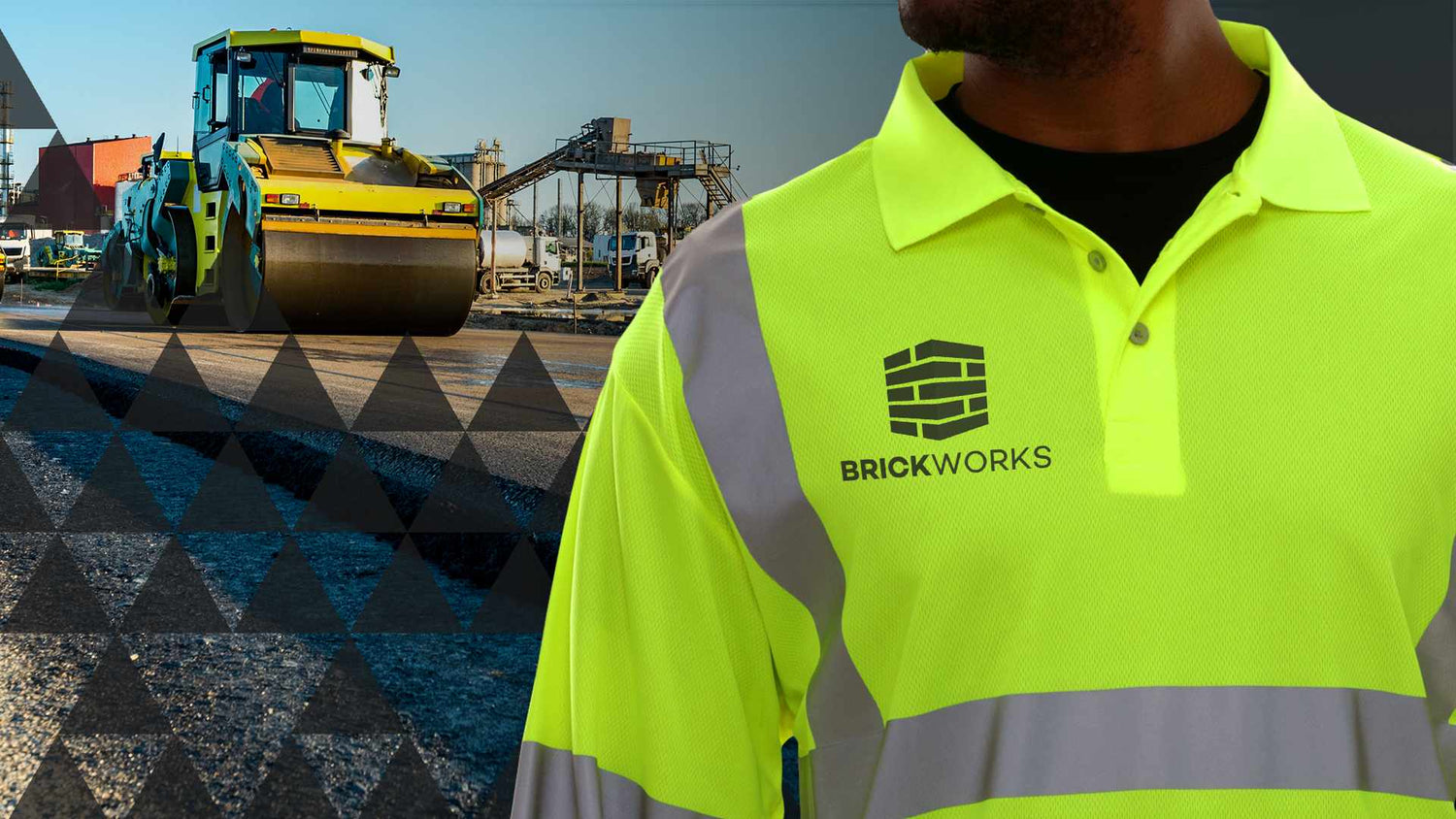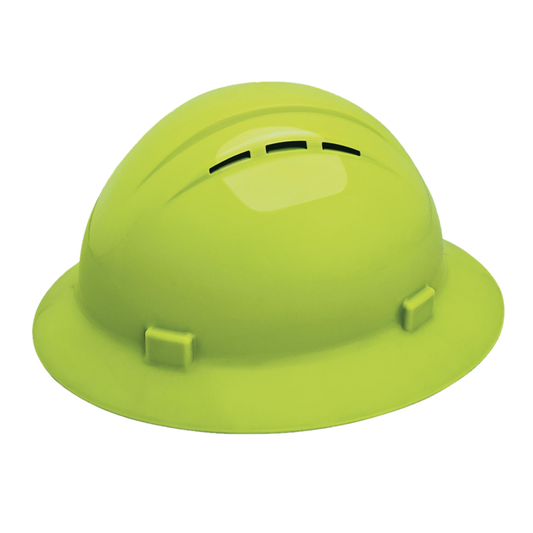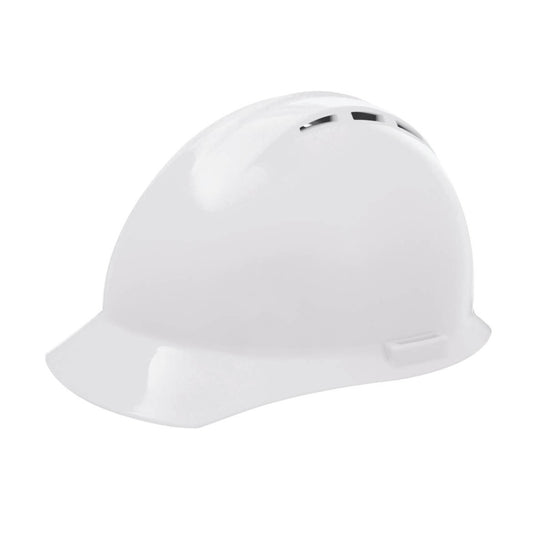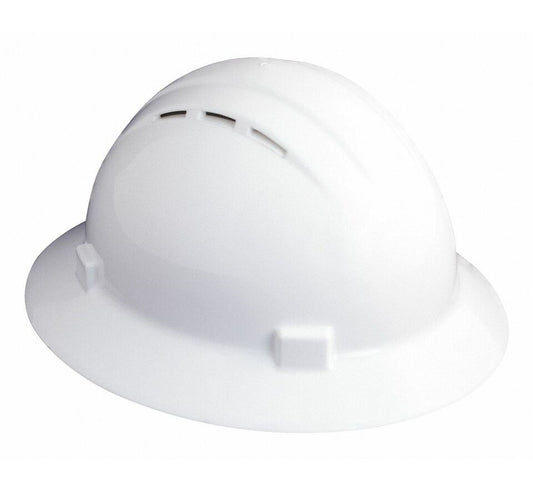-
HH 19430 Hi-Vis Lime Full Brim Vented Rachet Suspension Hard Hat
Regular price $14.40 MSRPRegular priceUnit price per -
HH 19451 White Standard Vented 4PT Rachet Suspension Hard Hat
Regular price $10.85 MSRPRegular priceUnit price per -
HH 19431 White Full Brim Vented Rachet Suspension Hard Hat
Regular price $14.40 MSRPRegular priceUnit price per -
HH 19450 Hi-Vis Lime Standard Vented 4PT Rachet Suspension Hard Hat
Regular price $10.85 MSRPRegular priceUnit price per
Frequently Asked Questions
Are Your Vented Hard Hats ANSI Compliant?
What is the Difference Between Type 1 and Type 2 Hard Hats?
Type 1 Hard Hats are designed to provide protection from impacts to the top of the head. This is typically used in environments where the primary hazard comes from falling objects striking the head from above. The standards for these hard hats are defined by ANSI Z89.1.
Type 2 Hard Hats provide protection not only from top impacts but also from lateral impacts, which can occur from blows to the side, front, or back of the head. This type of hard hat is typically used in environments where there is a risk of lateral as well as vertical impacts. They meet the more stringent ANSI Z89.1-2009 standards, which include rigorous tests for impact and penetration resistance from all directions.
What Are the Three Classifications of Hard Hats?
Hard hats are classified into three main categories based on their electrical insulation properties: Class G (General), Class E (Electrical), and Class C (Conductive).
Class G (General) Hard Hats are designed to reduce the force of impact and provide limited protection against electrical conductors, offering up to 2,200 volts of protection. They are commonly used in construction and other general applications.
Class E (Electrical) Hard Hats offer the highest level of electrical protection, up to 20,000 volts. These hard hats are essential for electricians and workers exposed to high-voltage environments.
Class C (Conductive) Hard Hats do not provide any electrical insulation and are primarily designed to protect against impact and penetration. They are typically used in environments where electrical hazards are not a concern, such as in certain industrial and manufacturing settings.
Each classification ensures that workers have the appropriate level of protection for their specific work conditions.
What are the Considerations When Choosing Between a Vented and Non-Vented Hard Hat?
The main difference between vented and non-vented hard hats lies in their design and functionality related to airflow and impact protection.
Vented Hard Hats have small vents or holes in the shell to allow air circulation, which helps keep the wearer cool and comfortable, particularly in hot or strenuous work environments. However, because of these vents, they do not provide protection against electrical hazards and are not suitable for environments where there is a risk of electrical shock.
Non-Vented Hard Hats have a solid shell with no vents, providing better protection against electrical hazards. They are designed to protect against impacts, penetration, and electrical shocks, making them suitable for use in environments where electrical safety is a concern. Non-vented hard hats are often used in construction, electrical work, and other industries where protection from electrical hazards is essential.
Choosing between vented and non-vented hard hats depends on the specific safety requirements and working conditions of the job.
What Colors and Sizes Are Available for Vented Full Brim Hard Hats?
Our vented full brim work hard hats are available in lime/yellow and white colors. Our vented hard hats Mega Ratchet Suspensions adjust to head sizes 6 ½” to 8.”
White Vented Hard Hats
Our lightweight white hard hats feature a ratchet suspension system ensuring comfort and safety. They are available in standard and full-brim styles, providing superior protection and air circulation
Lime/Yellow Vented Hard Hats
The durable yellow helmets are designed for high visibility and safety in industrial settings. Their vented air systems keep your head cool and dry, which is ideal for hot environments.
What Features Are Available for Vented Hard Hats?
Available features for our vented hard hats are listed below, enhancing safety and comfort for the wearer.
Vented Hard Hats Features and Benefits
- High-Density Polyethylene Construction: Ensures durability and impact resistance, meeting ANSI and OSHA compliance.
- Full Brim and Standard Designs: Offer additional protection from sun, rain, and debris.
- 4PT Ratchet Suspension System: Provides a secure, adjustable fit with shock-absorbing protection.
- Ventilation System: Strategically placed vents allow for better air circulation, keeping the wearer cool and comfortable.
- Hi-Vis Colors: Available in lime and white, improving visibility and safety on the job site.
- Lightweight Material: Reduces wearer fatigue for increased comfort during long work hours.
- Personalization Options: Available for branding and identification purposes.
What is the Difference Between a 4pt and 6pt Ratchet Suspension System?
4-point ratchet hard hats have a suspension system that connects to the hat at four points. They provide a standard level of protection by distributing the force of an impact across these four suspension points. These hard hats are suitable for many general construction and industrial environments.
6-point ratchet hard hats feature a suspension system that connects at six points, offering enhanced protection by distributing the force of an impact more effectively. This system can better absorb and dissipate energy, providing a higher level of safety. Additionally, 6-point hard hats are often considered more comfortable due to the even distribution of weight and pressure, which reduces the likelihood of pressure points. They are ideal for high-risk environments such as heavy construction and mining.
What Fabrics and Reflective Materials Do You Use For Vented Hard Hats?
Our vented hard hats are made from durable materials that comply with safety standards. Reflective safety strips incorporated into the design ensure visibility and safety in low-light conditions.
Our Vented Hard Hats Reflective Materials
- High-Density Polyethylene Construction: Ensures durability and impact resistance, meeting ANSI and OSHA compliance.
- Optional Reflective Strips: Enhances visibility in low-light conditions.
- Breathable and Moisture-Wicking Brow Pad: Provides additional comfort and sweat absorption.
- UV Protection Coating: Some models include coating the external shell to reduce UV degradation.
- ANSI-Compliant Materials: All materials used comply with ANSI safety standards, ensuring high-quality safety gear.
- Lightweight Fabric Linings: These are for added comfort without compromising the protective integrity of the hard hat.
What Customization Options Are Available For Ventilated Hard Hats?
Customization options include adding your logo on the hard hats to enhance brand visibility and compliance with company uniform standards.
Custom Vented Hard Hats For Your Company
We provide customization services, such as adding logos, which is ideal for companies looking to standardize their safety gear with their branding.
What Industries Do You Work With?
What Makes Your Vented Full Brim Hard Hats Great?
How Do You Wash Vented Hard Hats?
To maintain the effectiveness of your vented hard hats:
- Clean them regularly with mild soap and warm water.
- Avoid harsh chemicals and abrasives that could degrade the materials.
- Allow them to air dry completely before reuse to maintain the integrity of the ventilation system and reflective materials.





